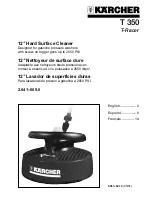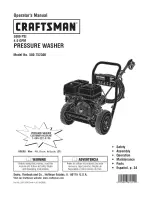
8
Turn off the water and then, turn the positioning mark
of the operating valve
(A)
until it stops at
.
• You can open the pressure cooker
- fig. 1 - 2
.
This method is used for soups, rice, pasta, cake and pud-
ding mixes, recipes containing rice or pasta and recipes
with a high liquid content.
If in doubt about which method of pressure release is cor-
rect, use the fast pressure release method.
•
When cooking frothy or starchy foods,
do not release
the pressure by turning the operating valve (A). Ins-
tead lift the pressure cooker away from the heat
source, leave the operating valve (A) in the cooking po-
sition and let the cooker cool slowly at room tempera-
ture (takes about 15 minutes) until the pressure
indicator drops down. Reduce the recommended coo-
king time a little.
• You can open the pressure cooker
- fig. 1 - 2.
Cleaning and maintenance
Cleaning the pressure cooker
To ensure the correct operation of your pressure
cooker, follow these cleaning and maintenance
recommendations after each use.
• Wash the pressure cooker (pan and lid) after
each use using warm water with washing-up
liquid in it. Follow the same procedure for the
basket*.
• Never use bleach or products containing chlorine.
• Do not overheat your pan when empty.
To clean the inside of the pan:
• Wash with a sponge pad and washing-up liquid.
• If the interior of the steel pan has an iridescent
sheen, clean it using white vinegar or a special
stainless steel cleaning product.
To clean the outside of the pan:
• Wash using a sponge and washing-up liquid.
Clean it with a special stainless steel cleaning
product.
*depending on model
Regularly check that
the pan handles are
attached properly.
Tighten them again
if necessary.
The browning and
marks which may
appear following
long term use do not
affect the operation
of the pressure
cooker.
For a longer
pressure cooker life,
do not overheat
your pressure
cooker pan when it
is empty.
EN
Summary of Contents for Clipso essential
Page 34: ...34 EL 2 3 TEFAL 2...
Page 36: ...36 EL TEFAL Clipso TEFAL TEFAL D 1 2 D 3 D D 6 7 5 9 X1010006 6 7 5 9 792654 792691...
Page 37: ...37 K 4 25 cl 2 5 2 3 6 75 cl K I 7 A C 8 9 A 10 11 EL...
Page 38: ...38 EL I 2 3 E 6 H I 7 A 9 20 20 E 1 2 C 12 F 3 4 A 8 9...
Page 39: ...39 PSCHHHT A E 13 E A 1 2 1 2 E 13 E EL...
Page 40: ...40 EL G 13 14 face c t couvercle A 10 11...
Page 41: ...41 A 15 A C A 10 11 C 12 16 F 17 TEFAL 18 TEFAL 10 E EL...
Page 42: ...42 EL F 19 20 A C F G TEFAL 1 2 3 4 5 6 7 8 9 10 11 TEFAL 10 E...
Page 43: ...43 TEFAL 10 TEFAL TEFAL L 211 4 L211 5 L211 12 1641 1649 PS PF EL...
Page 44: ...44 TEFAL C 3 D D K 4 TEFAL L autocuiseur est bien ferm EL...
Page 45: ...45 13 A 15 C 16 F 17 13 TEFAL EL...
Page 46: ...46 EL 4 6 500 50 6 1 1 6 30 2 1 4 1 1 1 4 30 20 4 15 10...
Page 47: ...47 2 1 250 1 2 1 1 1 2 25 2 2 30 10 1 1 5 8 1 1 15 5 30 15 4 20 65 EL...
Page 48: ...48 EL 4 150 1 1 1 2 1 2 60 3 1 15 750ml 2 500 3 1 4 3 1 1 20 5 15 4 25 7 5 15 40...
Page 102: ...102...









































